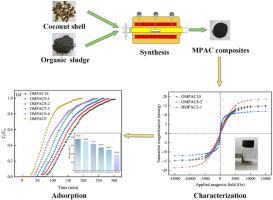磁性活性炭复合材料吸附去除二恶英
IF 4.7
3区 材料科学
Q2 MATERIALS SCIENCE, MULTIDISCIPLINARY
引用次数: 0
摘要
2024年,中国通过焚烧产生了约2.17亿吨城市固体废物,这些垃圾排放的烟气中含有二恶英。粉状活性炭(PAC)是常用的去除二恶英的方法,但其成本昂贵,每年的费用高达100亿元左右,并且增加了焚烧飞灰的毒性。磁性粉末活性炭(MPAC)提供了一种很有前途的替代品,但其在这一特定目的上的应用仍未得到充分探索。本研究采用椰壳(CS)和有机污泥(OS)的混合物一步热解和球磨两种方法合成MPAC。本研究利用二恶英替代物氯苯(CB)评价了该材料的吸附性能,并对MPAC样品进行了表征。结果表明,以CS:OS比为8:2的一步热解法合成的OMPAC8-2性能最佳。其BET表面积为773.91 m2 g−1,饱和磁化强度为18.60 emu·g−1,CB吸附量为317.11 mg g−1,是球磨MPAC的1.49倍。此外,经过5次再生循环后,OMPAC8-2仍保持了82%的吸附容量。因此,OMPAC8-2作为传统PAC的成本效益和可回收替代品,它推进了固体废物管理的“零废物”方法。本文章由计算机程序翻译,如有差异,请以英文原文为准。

Magnetic activated carbon composites for adsorptive removal of dioxin
In 2024, China generated about 217 million tons of municipal solid waste through incineration, which emits flue gas contaminated with dioxins. Powdered activated carbon (PAC) is commonly used to remove dioxins, but it is costly, with annual expenses amounting to around 10 billion CNY, and it increases the toxicity of incineration fly ash. Magnetic powdered activated carbon (MPAC) offers a promising alternative, yet its application for this specific purpose remains underexplored. This study synthesized MPAC using two methods: one-step pyrolysis, which uses blends of coconut shell (CS) and organic sludge (OS), and ball milling. The study evaluated the material's adsorption performance using chlorobenzene (CB), a surrogate for dioxins, and characterized the MPAC samples. Results showed that OMPAC8-2, which was synthesized via one-step pyrolysis with a CS:OS ratio of 8:2, exhibited optimal performance. It had a BET surface area of 773.91 m2 g−1, a saturation magnetization of 18.60 emu·g−1, and a CB adsorption capacity of 317.11 mg g−1, a value that is 1.49 times that of MPAC prepared by ball milling. Additionally, OMPAC8-2 retained 82 % of its adsorption capacity after five regeneration cycles. Thus, OMPAC8-2 acts as a cost-effective and recyclable alternative to traditional PAC, and it advances the "zero waste" approach to solid waste management.
求助全文
通过发布文献求助,成功后即可免费获取论文全文。
去求助
来源期刊

Materials Chemistry and Physics
工程技术-材料科学:综合
CiteScore
8.70
自引率
4.30%
发文量
1515
审稿时长
69 days
期刊介绍:
Materials Chemistry and Physics is devoted to short communications, full-length research papers and feature articles on interrelationships among structure, properties, processing and performance of materials. The Editors welcome manuscripts on thin films, surface and interface science, materials degradation and reliability, metallurgy, semiconductors and optoelectronic materials, fine ceramics, magnetics, superconductors, specialty polymers, nano-materials and composite materials.
 求助内容:
求助内容: 应助结果提醒方式:
应助结果提醒方式:


